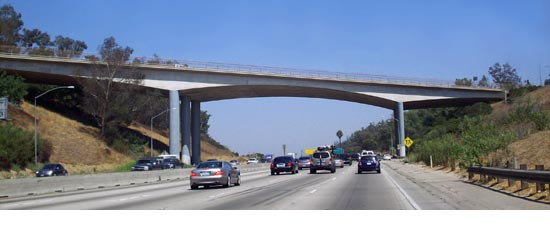Community wins 405 bridge change
September 29, 2010
Neighborhood traffic concerns—and the potential for saving millions in construction costs—have prompted a radical rethinking of plans to bring down the Mulholland Bridge over the 405 Freeway.
Instead of demolishing and rebuilding the 1959 structure—one of three bridges targeted in the 405 Sepulveda Pass project—workers instead would construct an entirely new Mulholland overpass just south of the current bridge. Coming from the west, drivers would enter the new bridge in the same place they do now, then angle slightly south across the freeway before ending up on Skirball Center Drive. Only after the new span was completed would the old one come down, thus reducing traffic-related inconvenience during construction.
Adopting the new approach is “about 99% sure,” said Mike Barbour, who is heading up the project for the Metropolitan Transportation Authority. He estimates the new method would save between $4 million and $10 million, most of that due to a more straightforward, single-phase building process and a more streamlined approach to temporarily relocating utilities.
The impetus to take another look at the construction plan grew out of meetings this summer with community activists concerned about how dismantling and rebuilding the Mulholland Bridge would affect traffic in the area, home to many educational and religious institutions.
There was applause when the new approach was announced at a recent meeting of the project’s Community Advisory Committee. The group was convened to provide input on the $1.034 billion project, a partnership between Metro and Caltrans that will create a 10-mile northbound carpool lane on the 405, along with other improvements.
“This group of decision-makers is actually listening to the public,” said Richard H. Close, president of the Sherman Oaks Homeowners Association and a member of the advisory committee, who was not at the recent meeting but took part in an earlier session where community concerns about the Mulholland Bridge were discussed. “They’re willing to redesign and solve a problem. It’s a much more collaborative process with the MTA than with other agencies.”
“On other projects, we’ve been told, ‘we are the experts.’” That may be true from an engineering standpoint, he said, but people who live in the area have an invaluable perspective, too: “We know traffic flow.”
He said Metro’s decision to take another look “is somewhat historic, especially on a transportation project.”
Still, other community concerns linger, many relating to the bridge at Skirball Center Drive, where demolition work on the northern side of the structure is slated to begin on October 12. Project plans currently call for freeway on- and off-ramps to be redirected onto Sepulveda Boulevard, rather than directly onto the bridge, as they are now. Residents say they fear the change will create traffic problems on Sepulveda.
“There are a lot of issues with the Skirball Bridge,” said Laurie Kelson, an advisory committee member and chair of the Encino Neighborhood Council’s traffic and transportation committee. “Our community does not want the ramps moved.”
Barbour said those concerns are being reviewed and alternatives are being evaluated. But he said he doesn’t see “a win/win at this point” regarding the Skirball ramps, given what the community wants and what traffic engineers say is needed for improved traffic flow.
Some also have posed questions in recent days about what a new Mulholland Bridge would look like, said Ron Macias, a Metro community relations officer. A 2007 Caltrans assessment described the current structure as an historic example of transportation engineering that “exemplifies the minimalist or modernist aesthetics of the period.”
And there are those, like Louis Krokover, president of the Encino Neighborhood Council and a 3rd generation builder, who argue that the Skirball and Mulholland bridges don’t need to be replaced at all.
Officials on the project say that building a wider freeway requires rebuilding and modernizing the three bridges, which, in addition to Skirball and Mulholland, include the bridge at Sunset Boulevard, whose southern side has been demolished and is now being rebuilt.
Barbour said he hopes that construction on the new Mulholland Bridge will start in January, 2011, and take about 12 months to complete.
He’s currently in the process of negotiating the new plan with the project’s contractors and working out details with the Los Angeles Department of Transportation.
And he credits the community groups—which he acknowledged frequently get “blown off” in dealing with public agencies—with sending his staff back to the drawing board. That review helped determine that the project had the right of way to land on which to build the new Mulholland Bridge, which made rethinking the process possible.
“They pushed us,” Barbour said. “They asked us and we went back and looked at it.”
Posted 9/29/10













 405 bridge work causes a stink
405 bridge work causes a stink

